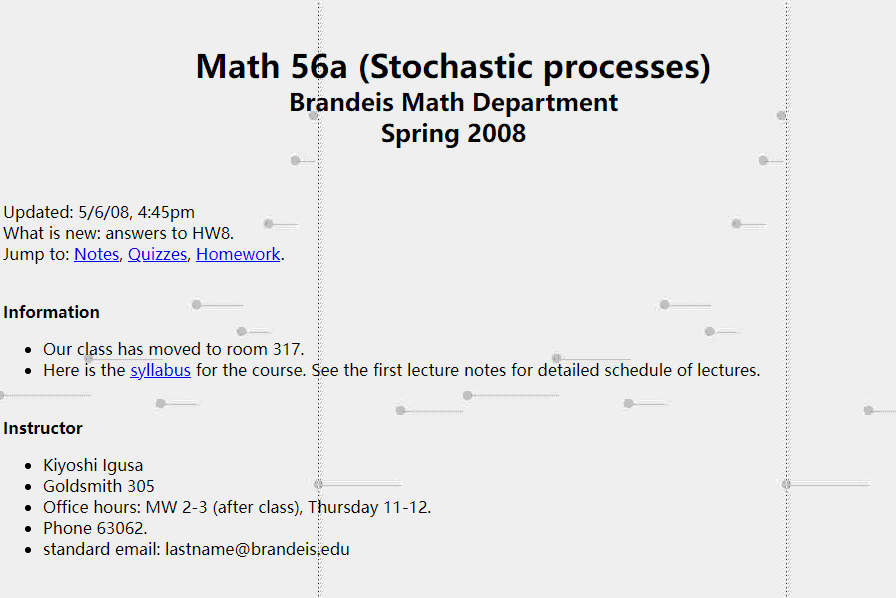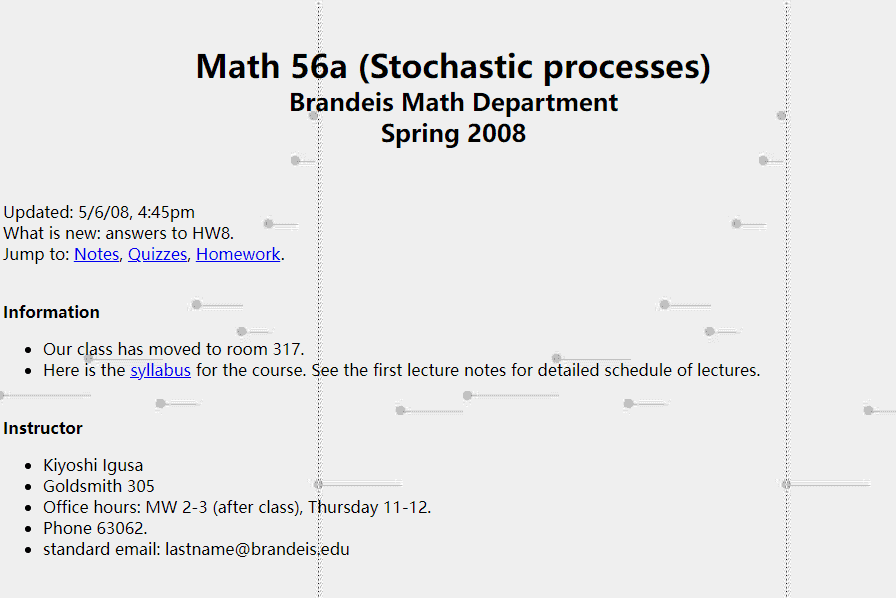MY-ASSIGNMENTEXPERT™可以为您提供brandeis.edu Math56a Stochastic Porcesses随机过程课程的代写代考和辅导服务!
这是布兰戴斯大学 随机过程课程的代写成功案例。

Math56a 课程简介
A stochastic process is a random process which evolves with time. The basic model is the Markov chain. This is a set of “states” together with transition probabilities from one state to another. For example, in simple epidemic models there are only two states: $S=$ “susceptible” and $I=$ “infected.” The probability of going from $S$ to $I$ increases with the size of $I$. In the simplest model The $S \rightarrow I$ probability is proportional to $I$, the $I \rightarrow S$ probability is constant and time is discrete (for example, events happen only once per day). In the corresponding deterministic model we would have a “difference equation.”
Prerequisites
In a continuous time Markov chain, transition events can occur at any time with a certain probability density. The corresponding deterministic model is a first order differential equation. This includes the “general stochastic epidemic.”
The number of states in a Markov chain is either finite or countably infinite. When the collection of states becomes a continuum, e.g., the price of a stock option, we no longer have a “Markov chain.” We have a more general stochastic process. Under very general conditions we obtain a Wiener process, also known as Brownian motion. The mathematics of hedging implies that stock options should be priced as if they are exactly given by this process. Ito’s formula explains how to calculate (or try to calculate) stochastic integrals which give the long term expected values for a Wiener process.
Math56a Stochastic Porcesses HELP(EXAM HELP, ONLINE TUTOR)
0.1. In the Kermack-McKendrick model, prove that the number of infected reaches its highest point when the number of susceptibles is equal to the threshold (or at $t=0$ at the beginning of the recorded $/$ modeled time period).
This is easy. You just need to look at the notes to see what the equations are.
The number of infected is
$$
y=N-x_0 e^{-z / \rho}-z
$$
where $N$ is the total population, $x_0$ is the initial number of infected, $z$ is the number of removed and $\rho$ is the threshold, a positive constant.
Since $d^2 y / d z^2<0$, the infected curve is concave down and reaches its highest point either at one endpoint or at the point where $d y / d z=0$. The epidemic cannot stop when $y>0$ because the infected are continually being removed. The numbers cannot stabilize until $y=0$. So, the maximum is either at the beginning (at $t=0, z=0$ ) or when $d y / d z=0$. But
$$
\frac{d y}{d z}=\frac{x_0}{\rho} e^{-z / \rho}-1=\frac{x}{\rho}-1
$$
since the number of susceptible is
$$
x=x_0 e^{-z / \rho} .
$$
So, $d y / d z=0$ if and only if $x=\rho$.
If the maximum occurs at the beginning then the epidemic is in its final stages and the maximum actually occurred earlier before we were recording the data.
0.2. Find all functions $x(t), y(t)$ so that
$$
x^{\prime}(t)=5 x-y, y^{\prime}(t)=3 x+y
$$
Find the particular solution with initial position $\left(x_0, y_0\right)=(1,3)$.
The matrix is
$$
A=\left(\begin{array}{cc}
5 & -1 \
3 & 1
\end{array}\right)
$$
This has eigenvalues 4,2 with corresponding eigenvectors $X_1=\left(\begin{array}{l}1 \ 1\end{array}\right), X_2=\left(\begin{array}{l}1 \ 3\end{array}\right)$. So $A=$ $Q D Q^{-1}$ where
$$
Q=\left(\begin{array}{ll}
1 & 1 \
1 & 3
\end{array}\right), \quad D=\left(\begin{array}{ll}
4 & 0 \
0 & 2
\end{array}\right), \quad Q^{-1}=\frac{1}{2}\left(\begin{array}{cc}
3 & -1 \
-1 & 1
\end{array}\right)
$$
And
$$
e^{t A}=Q e^{t D} Q^{-1}=\frac{1}{2}\left(\begin{array}{ll}
1 & 1 \
1 & 3
\end{array}\right)\left(\begin{array}{cc}
e^{4 t} & 0 \
0 & e^{2 t}
\end{array}\right)\left(\begin{array}{cc}
3 & -1 \
-1 & 1
\end{array}\right)=\frac{1}{2}\left(\begin{array}{cc}
3 e^{4 t}-e^{2 t} & -e^{4 t}+e^{2 t} \
3 e^{4 t}-3 e^{2 t} & -e^{4 t}+3 e^{2 t}
\end{array}\right)
$$
The general solution is $X=e^{t A} X_0$ or
$$
\begin{gathered}
x=\frac{x_0}{2}\left(3 e^{4 t}-e^{2 t}\right)+\frac{y_0}{2}\left(-e^{4 t}+e^{2 t}\right) \
y=\frac{x_0}{2}\left(3 e^{4 t}-3 e^{2 t}\right)+\frac{y_0}{2}\left(-e^{4 t}+3 e^{2 t}\right)
\end{gathered}
$$
When $x_0=1, y_0=3$ then the $e^{4 t}$ terms all cancel and we get
$$
x=e^{2 t}, \quad y=3 e^{2 t}
$$
0.3. Find all functions $f$ from integers to complex numbers so that
$$
f(n+1)=4 f(n)-5 f(n-1) .
$$
Now find the solution when $f(0)=f(1)=2$ and explain why it is real.
To solve the homogeneous equation, try $f=c^n$. If $c$ is a double root then the second solution is $f(n)=n c^n$. The equation is
$$
c^2-4 c+5=0
$$
This has two complex roots:
$$
c=2 \pm i
$$
So, the two linearly independent complex solutions are
$$
\begin{aligned}
& f_{+}(n)=(2+i)^n \
& f_{-}(n)=(2-i)^n
\end{aligned}
$$
The general complex solution is therefore given by
$$
f(n)=a(2+i)^n+b(2-i)^n
$$
where $a, b \in \mathbb{C}$.
Given the initial conditions $f(0)=f(1)=2$ we get:
$$
f(0)=a+b=2
$$
or: $b=2-a$.
$$
f(1)=a(2+i)+b(2-i)=a(2+i)+(2-a)(2-i)=2
$$
The solution is:
$$
a=1+i, \quad b=1-i
$$
So,
$$
f(n)=(1+i)(2+i)^n+(1-i)(2-i)^n
$$
This is a sequence of real number, in fact integers, since they are Gaussian integers which are equal to their own conjugates. (Gaussian integers are complex numbers of the form $a+i b$ where $a, b \in \mathbb{Z}$.)

MY-ASSIGNMENTEXPERT™可以为您提供BRANDEIS.EDU MATH56A STOCHASTIC PORCESSES随机过程课程的代写代考和辅导服务!
